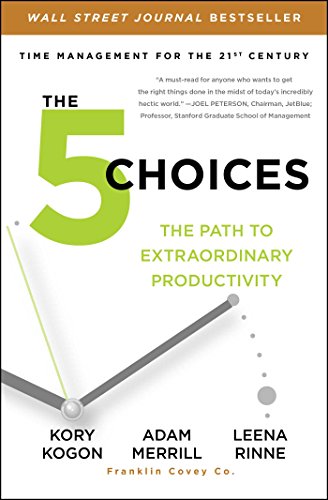The Five Choices: The Path to Extraordinary Productivity
If you enjoyed Franklin Covey's "7 Habits for Highly Effective People," you'll enjoy "The 5 Choices." This book got me started on my productivity journey in earnest.

Why I read it
I picked this up after taking a webinar titled "Time Management for Microsoft Outlook." It turned out to be the best 8-hour course I've ever taken because it kicked off the productivity journey I've been on for the past 7 years (!) now. The course didn't go into Microsoft Outlook right away. Instead, it covered the principles of the Five Choices.
I was so motivated by the course that I wanted to learn more and so I picked up the book on Amazon.
Here are the key insights
We feel buried today because of the productivity paradox:
It is both easier and harder than ever before to achieve extraordinary productivity and feel accomplished in our lives.
Because of the three challenges:
- We are making more decisions than ever.
- Our attention is under unprecedented attack.
- we are suffering from a personal energy crisis.
To counter both the productivity paradox and the three challenges above, we can apply the Five Choices:
Choice #1: Act on the Important, Don't React to the Urgent
Be intentional with your time and energy by understanding the Eisenhower matrix. You can learn about it here.
Know that there's:
- An "urgency addiction": People would rather work on/spend time on a think that is urgent (vice a thing that is important),
- And that there exists a "culture of busyness": This is where we place higher value on people that are buys (and may not necessarily productive).
We are a culture of people who've bought into the idea that if we stay busy enough, the truth of our lives won't catch up with us.
Above quote is from Brene Brown. Great author on resilience and whole-hearted living. I'll cover her work in future book reivews.
Choice #2: Go for the Extraordinary, Don't Settle for Ordinary
Establish your roles and goals:
- Know what your 5 to 7 roles in life are. Mine are Father, Husband, Engineer-Leader, Athlete, and Productivity and Efficiency Expert.
- Assess your performance in each of these areas. The books presents a spider diagram in assessing your performance on a three-part rating scale: underperforming, ordinary, extraordinary. (Hint: The goal is to assess yourself in each role as extraordinary.)
- This is one of my favorite parts of the book: Anchor your purpose and passion in your Q2 role title. This means finding the words for a title that captures the emotion, significance, and higher purpose in the role that you occupy. I've spent lots of time on this one idea of the book trying to find the right role titles for myself.
- Create your goal statements. Another framework presented here. Each goal should read: From X to Y by Z.
Choice #3: Schedule the Big Rocks, Don't Sort Gravel
The book begins with classic time management principles here. This is a great youtube video that I've used when teaching from the book.
The concept is straight out of Covey's "7 Habits for Highly Effective People". You need to know what the most important tasks/projects/events are and schedule those first. The fill in the lesser important tasks around that time. The stuff that doesn't get scheduled either schedule for a different week or don't do (because they weren't important to begin with).
Important concepts: 30/10 Promise
- 30 minutes of Weekly Planning time.
- 10 minutes of Daily Planning Time.
These two concepts are the weekly/daily maintenance activities which make your time management sustainable.
Choice #4: Rule your Technology, Don't Let it Rule You
The main point of this chapter is to develop an expertise in the time management tools that you use. Microsoft, Android, Mac, paper and pen ... it doesn't matter what you use. Master whatever tool that you choose to be the best time manager that you can be.
Three master moves:
- Win without fighting. Automate as much as you can to save your thinking effort to things that only you can do.
- Turn things into what they are. Turn things into what they are: Information that comes at you is either an (1) appointment, (2) task, (3) contact, or (4) note/document. You need to have a system that can convert information into one of these four things.
- Link to locate. This is about using links to find and share your important documents. Personally, I don't actively create links for my files. Instead, I use notetaking software (OneNote for work and Evernote for personal) because these two platforms have powerful search features which skips the need for creating and maintaining a filing structure.
Choice #5: Fuel your Fire, Don't Burn Out
Like an athlete who has trained very hard or recently completed a race, you need to to have time to rest and recover. There's five energy drivers: relax, connect, move, eat, and sleep. Pay attention to these and do them well. No matter how much of an expert you become in time management, neglecting these drivers will lead to burnout.
Get the book or pass?
Absolutely read the original.